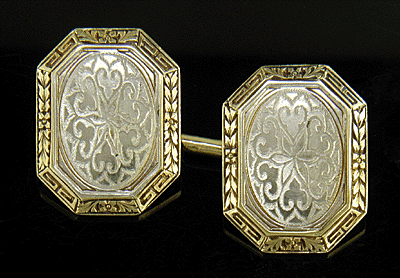 Gold and Platinum Cufflinks by the "L-maker."
Gold and Platinum Cufflinks by the "L-maker."
Every so often you will come across an elegant pair of gold and platinum cufflinks marked on the reverse with a small script "L". The cufflinks are usually rectangular in shape with beveled corners, much like an emerald-cut diamond. The tops are embellished with intricately engine-turned centers surrounded by foliate and geometric borders. I have nicknamed the unknown maker of these cufflinks the "L-maker". Here are a few examples.
Beautifully engine-turned 14kt yellow gold cufflinks with intricate acanthus leaf borders. These cufflinks are a nice example of the rich gold work characteristic of gentleman's jewelry in the early decades of the last century. Crafted by the "L-maker", circa 1920.

This pair beautifully displays the cool geometry of Art Deco design. Engraved and dimpled trapezoid borders surround chequered platinum centers. Crafted by the "L-maker" in 14kt gold and platinum, circa 1930.
The reverse of these cufflinks are stamped with precious metal marks and the maker's mark - a small script "L" in a lozenge (diamond shape). Hence the name "L-maker."

The mark is similar to the maker's mark of Lebolt & Co., a retail jeweler founded in Chicago in 1899. Inspired by the fashion for hand crafted silver in the early 1900s, Myer Lebolt, founder of the firm, opened a workshop to create custom silver pieces for his retail stores in Chicago and New York. Eventually the workshop included goldsmiths and platinumsmiths who created jewelry in addition to the firm's sterling flatware and holloware. It is possible these elegant cufflinks were created in the Lebolt workshop during the 1920s.
At this time, an attribution of these cufflinks to Lebolt & Co. is only a working hypothesis. The similarity of the marks is suggestive, but not conclusive. It is wise to confirm the identification of an unknown maker's mark with other sources such as old catalogs, original sales receipts and period advertisements. Family recollections and company names on jewelry boxes can also be helpful, but are sometimes less reliable. The mystery of the "L-maker" may be closer to a solution, but further research remains to be done.
If you would like to read more about Lebolt & Co. and the Chicago silversmiths, there is a wonderful book, Chicago Metalsmiths, by Sharon Darling. Although the book is out of print, it is worth a trip to the library or a secondhand book shop to find a copy.


No comments:
Post a Comment